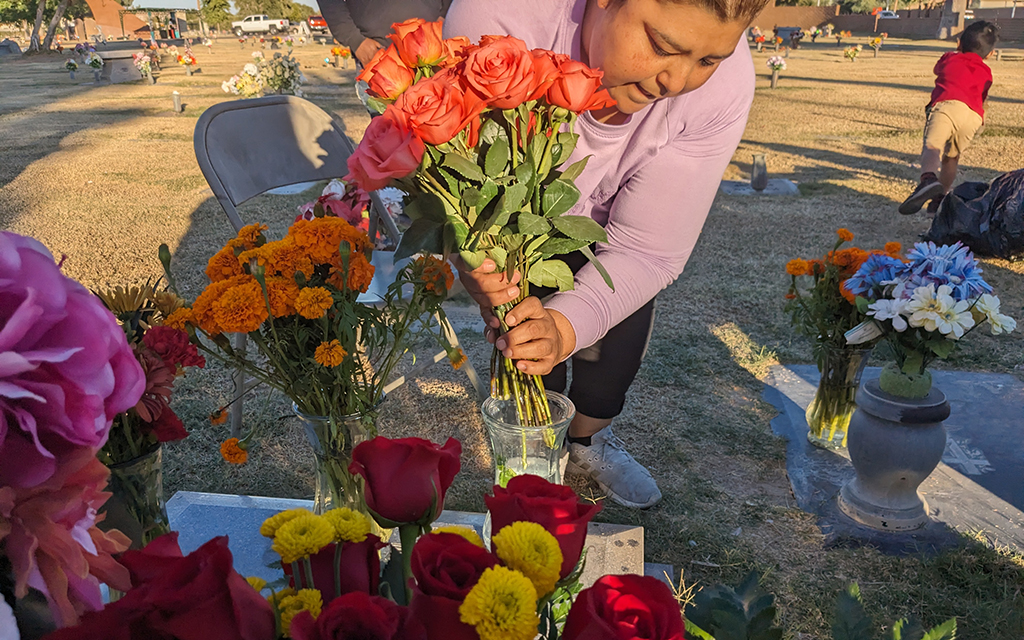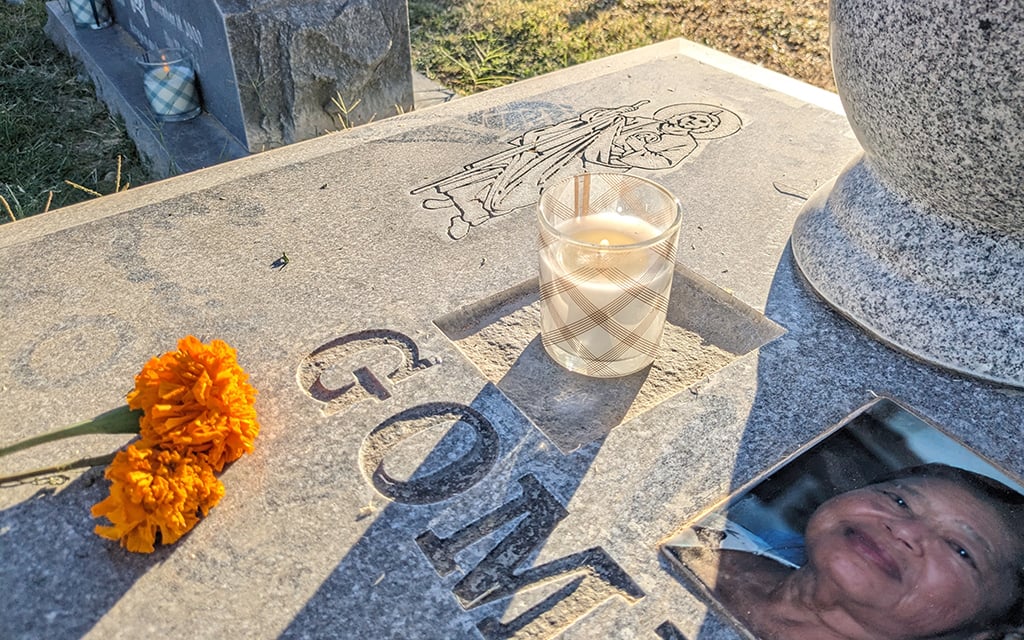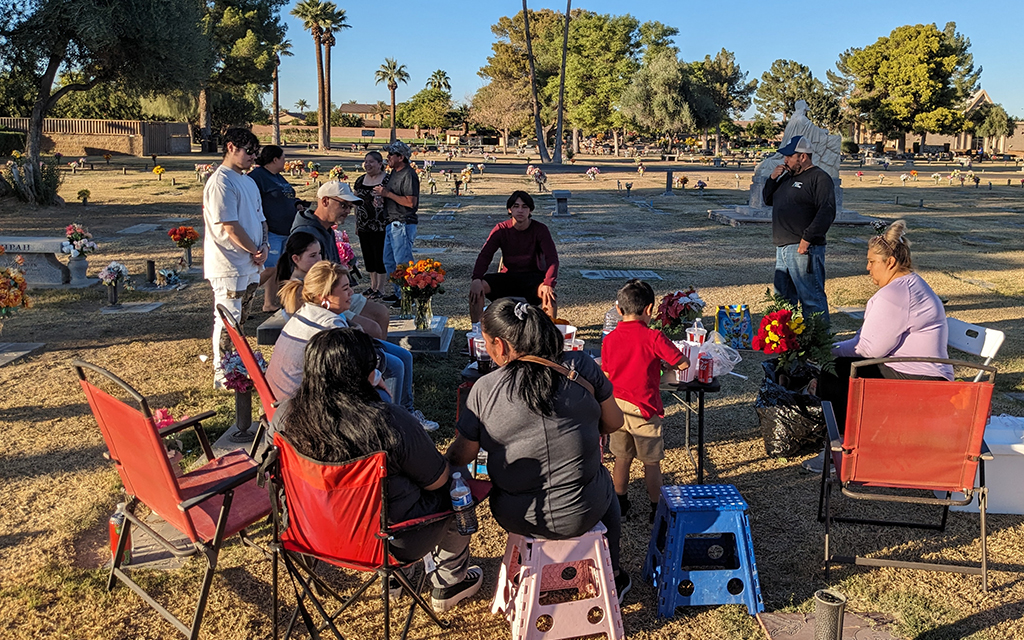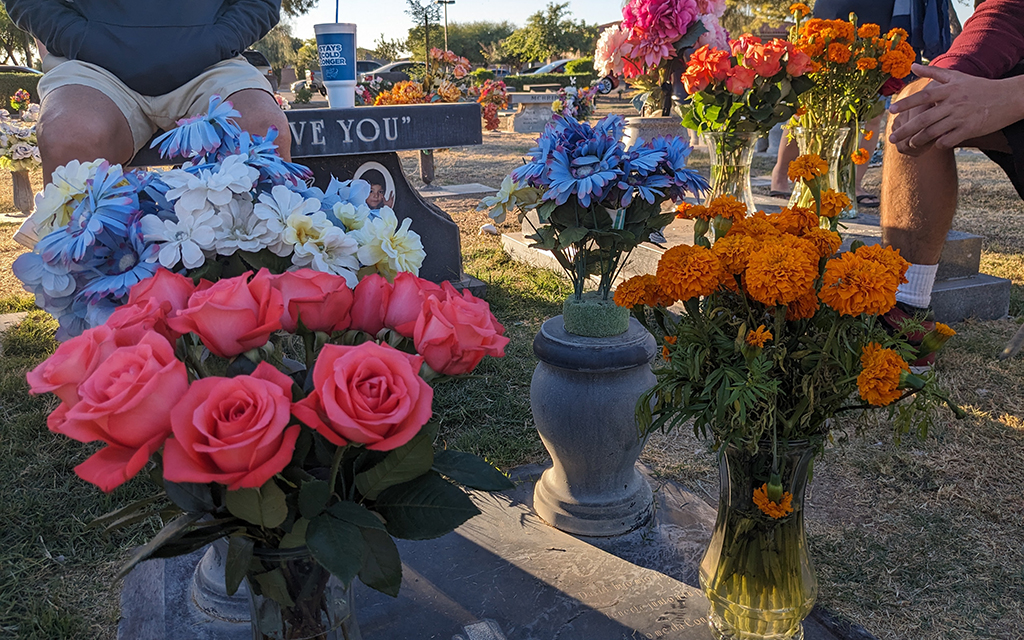CHANDLER — On the second night of Dia de los Muertos, just inside the otherwise empty Valley of the Sun Mortuary and Cemetery, sisters Miriam Bryant and Ana Gomez sat with 11 of their closest family members and friends around three flower-covered grave sites.
Their mother is buried there, right next to Gomez’s husband and son.
Dia de los Muertos – also known as Day of the Dead – which spanned Wednesday and Thursday, is a Mexican holiday dedicated to remembering and honoring deceased relatives and loved ones. It is believed that the spirits of those who have died are able to visit their families on these days.
For many, Dia de los Muertos isn’t necessarily a day of mourning. It’s more of a celebration, a chance to spend time with family and connect with the spirits of their loved ones. Every year, when Bryant and Gomez visit the grave sites, they can feel the presence of their deceased family members.
“It’s kind of like in the air, and then, like, a little bird comes and stands there,” Gomez said. “I don’t know if it’s true or not, but I like to believe that. I like to believe that they’re here.”
Bryant said she tries to visit the graves every Sunday with her family members, but their busy schedules make it difficult. The tradition of Dia de los Muertos brings everyone together for at least one night a year.
“I love being here; if I could come every day, I would be happy,” she said. “We don’t do this very often, you know, because everybody works and they’ve got their own things, so we don’t really get together with the whole family.”
The family brought food from KFC to eat while they decorated the graves with papel picado – decorative cut-paper art – candles and bright orange marigolds, which are considered to be the traditional Dia de los Muertos flowers. The combined smells of the flowers and candles are believed to attract the souls of the deceased.
Candles aren’t allowed to be left inside the cemetery, Gomez said, so the family only lets them burn while they’re present.
“But in Mexico, you leave everything,” she said, “it’s a big party.”
The sisters grew up in Mexico, celebrating Dia de los Muertos with their grandparents. Bryant said that in Mexico celebrations are typically very large and vibrant, but in Arizona they celebrate the holiday more intimately.
“When we got here, in the beginning, we had nobody in here (the cemetery),” Gomez said. “So when my husband and son passed away, we started coming to do the tradition.”

At Ana Gomez’s home, the family ofrenda holds photos of deceased loved ones along with some of their favorite food and drinks. (Photo courtesy of Miriam Bryant)
Their family ofrenda, or altar, used to be set up in their mother’s home, honoring deceased grandparents, uncles and aunts. When their mother died three years ago, Gomez took on the responsibility and now sets up the ofrenda in her house every year.
“I spent most of the day at her house,” Bryant said. “I said, ‘I don’t know how you’re doing this.’ She cooked all day.”
The family adorned the ofrenda with food Gomez prepared, including pozole, tamales, mole, sweet potatoes, pumpkins, pan dulce, candy and fruit.
“We put candies and their favorite food and their sodas because mama was crazy for her Diet Coke,” Bryant said.
Just as they did with the grave sites, the family decorated their ofrenda with papel picado, candles and flowers.
The sisters arrived at the cemetery at 4 p.m. and stayed with their family and friends until 7 p.m., enjoying the time spent with one another and feeling closer to those they lost.
“I know a lot of people think that we’re crazy because, I mean, they’re not here,” Bryant said. “But in my belief, they are. When we have that thing (the ofrenda) in the house, the food and stuff, I feel like they come visit with their spirit.”
Even though Dia de los Muertos ended Thursday, celebrations in Arizona are set to continue through the weekend. The Desert Botanical Garden in Phoenix will host a two-day celebration Saturday and Sunday with food, music and a community altar. Arizona State University Preparatory Academy in South Phoenix will host a Dia de los Muertos community celebration as well on Saturday evening.
U.S. Reps. Raúl M. Grijalva, from Arizona, and Jesús G. “Chuy” García, from Illinois, both Democrats, reintroduced a resolution to commemorate the holiday, and Grijalva created a community ofrenda in Tucson that will be on display for several weeks.




